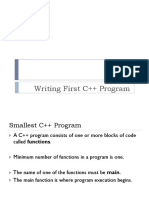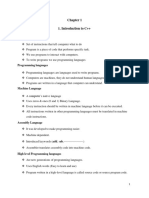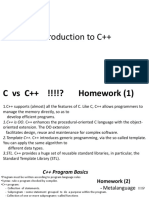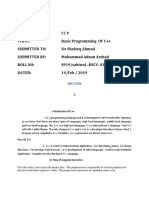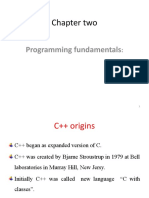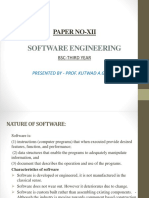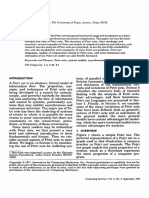Chapter 2.
C++ BASICS
Chapter 2. C++ BASICS
Minh Quang Nguyen
Hanoi National University of Education
September 2015
�Chapter 2. C++ BASICS
The structure of a C++ program
Input/output stream
Operator
Fundamental statement: loop and conditional statement
FUNCTIONs
�Chapter 2. C++ BASICS
The structure of a C++ program
An example
There must be one and
only one function name
main in a program.
#include <iostream.h>
using namespace std;
int main()
{
cout << \Hello world \n";
return 0;
}
Statement is isolated by
;
#include: add a library
into source code
using namespace: add a
library into source code
Comment in one line, using
//, in multiple lines using
/* comment */
�Chapter 2. C++ BASICS
The structure of a C++ program
Variables
A variable is a storage location paired with an associated symbolic
name (an identifier), which contains some known or unknown
quantity of information referred to as a value.
To define a variable:
Data type variable name;
or
Data type variable name = value;
Example:
int a;
int a, b = 10;
�Chapter 2. C++ BASICS
The structure of a C++ program
Variables
I
A variable must be defined before any use
Definition for a variable can be located anywhere in a
program.
Naming conventions:
I
I
Case sensitive
Only contains: a-z, A-Z, 0-9 and
Example:
int total_student;
char _student_name;
�Chapter 2. C++ BASICS
The structure of a C++ program
Variables
I
A variable must be defined before any use
Definition for a variable can be located anywhere in a
program.
Naming conventions:
I
I
Case sensitive
Only contains: a-z, A-Z, 0-9 and
Example:
int total_student;
char _student_name;
�Chapter 2. C++ BASICS
The structure of a C++ program
Variables
I
I
Integer - int, long, short
Character - char: store ASCII value of a charater.
I
I
It must be in .
Special charater:
n,
tab,
,...
Unsigned numbers: unsigned char, unsigned in,
unsigned short, unsigned long
Real number: float, double, long double
bool: true/false
�Chapter 2. C++ BASICS
The structure of a C++ program
Variables
I
I
Integer - int, long, short
Character - char: store ASCII value of a charater.
I
I
It must be in .
Special charater:
n,
tab,
,...
Unsigned numbers: unsigned char, unsigned in,
unsigned short, unsigned long
Real number: float, double, long double
bool: true/false
�Chapter 2. C++ BASICS
The structure of a C++ program
Variables
I
I
Integer - int, long, short
Character - char: store ASCII value of a charater.
I
I
It must be in .
Special charater:
n,
tab,
,...
Unsigned numbers: unsigned char, unsigned in,
unsigned short, unsigned long
Real number: float, double, long double
bool: true/false
�Chapter 2. C++ BASICS
The structure of a C++ program
Variables
I
I
Integer - int, long, short
Character - char: store ASCII value of a charater.
I
I
It must be in .
Special charater:
n,
tab,
,...
Unsigned numbers: unsigned char, unsigned in,
unsigned short, unsigned long
Real number: float, double, long double
bool: true/false
�Chapter 2. C++ BASICS
The structure of a C++ program
Variables
I
I
Integer - int, long, short
Character - char: store ASCII value of a charater.
I
I
It must be in .
Special charater:
n,
tab,
,...
Unsigned numbers: unsigned char, unsigned in,
unsigned short, unsigned long
Real number: float, double, long double
bool: true/false
�Chapter 2. C++ BASICS
The structure of a C++ program
Variables
I
I
Integer - int, long, short
Character - char: store ASCII value of a charater.
I
I
It must be in .
Special charater:
n,
tab,
,...
Unsigned numbers: unsigned char, unsigned in,
unsigned short, unsigned long
Real number: float, double, long double
bool: true/false
�Chapter 2. C++ BASICS
The structure of a C++ program
Variables
I
I
Integer - int, long, short
Character - char: store ASCII value of a charater.
I
I
It must be in .
Special charater:
n,
tab,
,...
Unsigned numbers: unsigned char, unsigned in,
unsigned short, unsigned long
Real number: float, double, long double
bool: true/false
�Chapter 2. C++ BASICS
The structure of a C++ program
Variables
I
I
Integer - int, long, short
Character - char: store ASCII value of a charater.
I
I
It must be in .
Special charater:
n,
tab,
,...
Unsigned numbers: unsigned char, unsigned in,
unsigned short, unsigned long
Real number: float, double, long double
bool: true/false
�Chapter 2. C++ BASICS
The structure of a C++ program
Variables
Type
char
short
int
long
float
double
long double
Low
-128
-32768
-2147483648
-2147483648
3.4 1038
1.7 10308
3.4 104932
High
127
32767
2147483647
2147483647
3.4 1038
1.7 10308
3.4 104932
Bytes
1
2
4
4
4
4
10
�Chapter 2. C++ BASICS
The structure of a C++ program
Constant variables
Constant variable is a variable with a fix value. 2 ways to define a
constant variable:
I
const float PI = 3.14;
#define PI 3.14
�Chapter 2. C++ BASICS
The structure of a C++ program
Constant variables
Constant variable is a variable with a fix value. 2 ways to define a
constant variable:
I
const float PI = 3.14;
#define PI 3.14
�Chapter 2. C++ BASICS
The structure of a C++ program
Constant variables
Constant variable is a variable with a fix value. 2 ways to define a
constant variable:
I
const float PI = 3.14;
#define PI 3.14
�Chapter 2. C++ BASICS
The structure of a C++ program
Constant variables
Constant variable is a variable with a fix value. 2 ways to define a
constant variable:
I
const float PI = 3.14;
#define PI 3.14
�Chapter 2. C++ BASICS
The structure of a C++ program
Constant variables
Constant variable is a variable with a fix value. 2 ways to define a
constant variable:
I
const float PI = 3.14;
#define PI 3.14
�Chapter 2. C++ BASICS
Input/output stream
Using cout
cout is an object defined by stdio in C++, it is responsible to
display the output and corresponds to standard output stream.
Operation << directs the data to object cout. Example
I
int i = 8;
cout << The value of i is: << i << endl;
cout << The value of i is: << i <<
n;
Homework: learn about setw - How to use it? How does it work?
�Chapter 2. C++ BASICS
Input/output stream
Using cout
cout is an object defined by stdio in C++, it is responsible to
display the output and corresponds to standard output stream.
Operation << directs the data to object cout. Example
I
int i = 8;
cout << The value of i is: << i << endl;
cout << The value of i is: << i <<
n;
Homework: learn about setw - How to use it? How does it work?
�Chapter 2. C++ BASICS
Input/output stream
Using cout
cout is an object defined by stdio in C++, it is responsible to
display the output and corresponds to standard output stream.
Operation << directs the data to object cout. Example
I
int i = 8;
cout << The value of i is: << i << endl;
cout << The value of i is: << i <<
n;
Homework: learn about setw - How to use it? How does it work?
�Chapter 2. C++ BASICS
Input/output stream
Using cout
cout is an object defined by stdio in C++, it is responsible to
display the output and corresponds to standard output stream.
Operation << directs the data to object cout. Example
I
int i = 8;
cout << The value of i is: << i << endl;
cout << The value of i is: << i <<
n;
Homework: learn about setw - How to use it? How does it work?
�Chapter 2. C++ BASICS
Input/output stream
Using cout
cout is an object defined by stdio in C++, it is responsible to
display the output and corresponds to standard output stream.
Operation << directs the data to object cout. Example
I
int i = 8;
cout << The value of i is: << i << endl;
cout << The value of i is: << i <<
n;
Homework: learn about setw - How to use it? How does it work?
�Chapter 2. C++ BASICS
Input/output stream
Using cout
cout is an object defined by stdio in C++, it is responsible to
display the output and corresponds to standard output stream.
Operation << directs the data to object cout. Example
I
int i = 8;
cout << The value of i is: << i << endl;
cout << The value of i is: << i <<
n;
Homework: learn about setw - How to use it? How does it work?
�Chapter 2. C++ BASICS
Input/output stream
Using cout
cout is an object defined by stdio in C++, it is responsible to
display the output and corresponds to standard output stream.
Operation << directs the data to object cout. Example
I
int i = 8;
cout << The value of i is: << i << endl;
cout << The value of i is: << i <<
n;
Homework: learn about setw - How to use it? How does it work?
�Chapter 2. C++ BASICS
Input/output stream
Using cout
cout is an object defined by stdio in C++, it is responsible to
display the output and corresponds to standard output stream.
Operation << directs the data to object cout. Example
I
int i = 8;
cout << The value of i is: << i << endl;
cout << The value of i is: << i <<
n;
Homework: learn about setw - How to use it? How does it work?
�Chapter 2. C++ BASICS
Input/output stream
Using cout
cout is an object defined by stdio in C++, it is responsible to
display the output and corresponds to standard output stream.
Operation << directs the data to object cout. Example
I
int i = 8;
cout << The value of i is: << i << endl;
cout << The value of i is: << i <<
n;
Homework: learn about setw - How to use it? How does it work?
�Chapter 2. C++ BASICS
Input/output stream
Using cin
The standard input by default is the keyboard, and the C++
stream object defined to access it is cin For formatted input
operations, cin is used together with the extraction operator, which
is written as Example
I
int i;
cout << Input a value for i << endl;
cin i;
�Chapter 2. C++ BASICS
Input/output stream
Using cin
The standard input by default is the keyboard, and the C++
stream object defined to access it is cin For formatted input
operations, cin is used together with the extraction operator, which
is written as Example
I
int i;
cout << Input a value for i << endl;
cin i;
�Chapter 2. C++ BASICS
Input/output stream
Using cin
The standard input by default is the keyboard, and the C++
stream object defined to access it is cin For formatted input
operations, cin is used together with the extraction operator, which
is written as Example
I
int i;
cout << Input a value for i << endl;
cin i;
�Chapter 2. C++ BASICS
Input/output stream
Using cin
The standard input by default is the keyboard, and the C++
stream object defined to access it is cin For formatted input
operations, cin is used together with the extraction operator, which
is written as Example
I
int i;
cout << Input a value for i << endl;
cin i;
�Chapter 2. C++ BASICS
Input/output stream
Using cin
The standard input by default is the keyboard, and the C++
stream object defined to access it is cin For formatted input
operations, cin is used together with the extraction operator, which
is written as Example
I
int i;
cout << Input a value for i << endl;
cin i;
�Chapter 2. C++ BASICS
Input/output stream
Using cin
The standard input by default is the keyboard, and the C++
stream object defined to access it is cin For formatted input
operations, cin is used together with the extraction operator, which
is written as Example
I
int i;
cout << Input a value for i << endl;
cin i;
�Chapter 2. C++ BASICS
Input/output stream
Using cin
The standard input by default is the keyboard, and the C++
stream object defined to access it is cin For formatted input
operations, cin is used together with the extraction operator, which
is written as Example
I
int i;
cout << Input a value for i << endl;
cin i;
�Chapter 2. C++ BASICS
Input/output stream
Header file and library file
Why we need header files?
I
It speeds up compile time.
It keeps your code more organized.
It allows you to separate interface from implementation.
Lets see an example
�Chapter 2. C++ BASICS
Input/output stream
Header file and library file
Why we need header files?
I
It speeds up compile time.
It keeps your code more organized.
It allows you to separate interface from implementation.
Lets see an example
�Chapter 2. C++ BASICS
Input/output stream
Header file and library file
Why we need header files?
I
It speeds up compile time.
It keeps your code more organized.
It allows you to separate interface from implementation.
Lets see an example
�Chapter 2. C++ BASICS
Input/output stream
Header file and library file
Why we need header files?
I
It speeds up compile time.
It keeps your code more organized.
It allows you to separate interface from implementation.
Lets see an example
�Chapter 2. C++ BASICS
Input/output stream
Header file and library file (cont.)
Two kinds of library
I
You build it yourself
#include myprog.h
In the standard directory of C++.
#include math.h
Lets see an other example
�Chapter 2. C++ BASICS
Input/output stream
Header file and library file (cont.)
Two kinds of library
I
You build it yourself
#include myprog.h
In the standard directory of C++.
#include math.h
Lets see an other example
�Chapter 2. C++ BASICS
Input/output stream
Header file and library file (cont.)
Two kinds of library
I
You build it yourself
#include myprog.h
In the standard directory of C++.
#include math.h
Lets see an other example
�Chapter 2. C++ BASICS
Operator
Operators
Three kinds of Operator
I
Mathematical operator
Relational operator
Logical operator
�Chapter 2. C++ BASICS
Operator
Operators
Three kinds of Operator
I
Mathematical operator
Relational operator
Logical operator
�Chapter 2. C++ BASICS
Operator
Operators
Three kinds of Operator
I
Mathematical operator
Relational operator
Logical operator
�Chapter 2. C++ BASICS
Operator
Operators
Three kinds of Operator
I
Mathematical operator
Relational operator
Logical operator
�Chapter 2. C++ BASICS
Operator
Mathematical Operator
I
Addition +
Subtraction -
Multiple *
Division /
Reminder
int a = 7/3; // a = ?
float b = 1/3; //b = 0.333
int b = 10 % a; // b = 0
Example
�Chapter 2. C++ BASICS
Operator
Mathematical Operator
I
Addition +
Subtraction -
Multiple *
Division /
Reminder
int a = 7/3; // a = ?
float b = 1/3; //b = 0.333
int b = 10 % a; // b = 0
Example
�Chapter 2. C++ BASICS
Operator
Mathematical Operator
I
Addition +
Subtraction -
Multiple *
Division /
Reminder
int a = 7/3; // a = ?
float b = 1/3; //b = 0.333
int b = 10 % a; // b = 0
Example
�Chapter 2. C++ BASICS
Operator
Mathematical Operator
I
Addition +
Subtraction -
Multiple *
Division /
Reminder
int a = 7/3; // a = ?
float b = 1/3; //b = 0.333
int b = 10 % a; // b = 0
Example
�Chapter 2. C++ BASICS
Operator
Mathematical Operator
I
Addition +
Subtraction -
Multiple *
Division /
Reminder
int a = 7/3; // a = ?
float b = 1/3; //b = 0.333
int b = 10 % a; // b = 0
Example
�Chapter 2. C++ BASICS
Operator
Mathematical Operator
I
Addition +
Subtraction -
Multiple *
Division /
Reminder
int a = 7/3; // a = ?
float b = 1/3; //b = 0.333
int b = 10 % a; // b = 0
Example
�Chapter 2. C++ BASICS
Operator
Mathematical Operator
I
Addition +
Subtraction -
Multiple *
Division /
Reminder
int a = 7/3; // a = ?
float b = 1/3; //b = 0.333
int b = 10 % a; // b = 0
Example
�Chapter 2. C++ BASICS
Operator
Relational Operator
Only release one in two value: TRUE or FALSE
I
Greater than:
Greater than or equal to:
Lower than:
Lower than or equal to:
Equal:
Different:
int a
float
(a ==
(a >=
Example
= 7/3; // a = ?
b = 1/3; //b = 0.333
b) // false
b) //true
�Chapter 2. C++ BASICS
Operator
Relational Operator
Only release one in two value: TRUE or FALSE
I
Greater than:
Greater than or equal to:
Lower than:
Lower than or equal to:
Equal:
Different:
int a
float
(a ==
(a >=
Example
= 7/3; // a = ?
b = 1/3; //b = 0.333
b) // false
b) //true
�Chapter 2. C++ BASICS
Operator
Relational Operator
Only release one in two value: TRUE or FALSE
I
Greater than:
Greater than or equal to:
Lower than:
Lower than or equal to:
Equal:
Different:
int a
float
(a ==
(a >=
Example
= 7/3; // a = ?
b = 1/3; //b = 0.333
b) // false
b) //true
�Chapter 2. C++ BASICS
Operator
Relational Operator
Only release one in two value: TRUE or FALSE
I
Greater than:
Greater than or equal to:
Lower than:
Lower than or equal to:
Equal:
Different:
int a
float
(a ==
(a >=
Example
= 7/3; // a = ?
b = 1/3; //b = 0.333
b) // false
b) //true
�Chapter 2. C++ BASICS
Operator
Relational Operator
Only release one in two value: TRUE or FALSE
I
Greater than:
Greater than or equal to:
Lower than:
Lower than or equal to:
Equal:
Different:
int a
float
(a ==
(a >=
Example
= 7/3; // a = ?
b = 1/3; //b = 0.333
b) // false
b) //true
�Chapter 2. C++ BASICS
Operator
Relational Operator
Only release one in two value: TRUE or FALSE
I
Greater than:
Greater than or equal to:
Lower than:
Lower than or equal to:
Equal:
Different:
int a
float
(a ==
(a >=
Example
= 7/3; // a = ?
b = 1/3; //b = 0.333
b) // false
b) //true
�Chapter 2. C++ BASICS
Operator
Relational Operator
Only release one in two value: TRUE or FALSE
I
Greater than:
Greater than or equal to:
Lower than:
Lower than or equal to:
Equal:
Different:
int a
float
(a ==
(a >=
Example
= 7/3; // a = ?
b = 1/3; //b = 0.333
b) // false
b) //true
�Chapter 2. C++ BASICS
Operator
Relational Operator
Only release one in two value: TRUE or FALSE
I
Greater than:
Greater than or equal to:
Lower than:
Lower than or equal to:
Equal:
Different:
int a
float
(a ==
(a >=
Example
= 7/3; // a = ?
b = 1/3; //b = 0.333
b) // false
b) //true
�Chapter 2. C++ BASICS
Operator
Logical operator
It combines several logical values and release one in two value:
TRUE or FALSE
I
AND:
OR:
NOT:
Conditional operator condition ? true expression:false
expression
int a
float
(a ==
(a ==
int c
Example
= 7/3; // a = ?
b = 1/3; //b = 0.333
b) || (a != b) // true
b) && (a != b) // false
= (a < b) ? 5 : 7; // c = 5? c = 7?
�Chapter 2. C++ BASICS
Operator
Logical operator
It combines several logical values and release one in two value:
TRUE or FALSE
I
AND:
OR:
NOT:
Conditional operator condition ? true expression:false
expression
int a
float
(a ==
(a ==
int c
Example
= 7/3; // a = ?
b = 1/3; //b = 0.333
b) || (a != b) // true
b) && (a != b) // false
= (a < b) ? 5 : 7; // c = 5? c = 7?
�Chapter 2. C++ BASICS
Operator
Logical operator
It combines several logical values and release one in two value:
TRUE or FALSE
I
AND:
OR:
NOT:
Conditional operator condition ? true expression:false
expression
int a
float
(a ==
(a ==
int c
Example
= 7/3; // a = ?
b = 1/3; //b = 0.333
b) || (a != b) // true
b) && (a != b) // false
= (a < b) ? 5 : 7; // c = 5? c = 7?
�Chapter 2. C++ BASICS
Operator
Logical operator
It combines several logical values and release one in two value:
TRUE or FALSE
I
AND:
OR:
NOT:
Conditional operator condition ? true expression:false
expression
int a
float
(a ==
(a ==
int c
Example
= 7/3; // a = ?
b = 1/3; //b = 0.333
b) || (a != b) // true
b) && (a != b) // false
= (a < b) ? 5 : 7; // c = 5? c = 7?
�Chapter 2. C++ BASICS
Operator
Logical operator
It combines several logical values and release one in two value:
TRUE or FALSE
I
AND:
OR:
NOT:
Conditional operator condition ? true expression:false
expression
int a
float
(a ==
(a ==
int c
Example
= 7/3; // a = ?
b = 1/3; //b = 0.333
b) || (a != b) // true
b) && (a != b) // false
= (a < b) ? 5 : 7; // c = 5? c = 7?
�Chapter 2. C++ BASICS
Operator
Logical operator
It combines several logical values and release one in two value:
TRUE or FALSE
I
AND:
OR:
NOT:
Conditional operator condition ? true expression:false
expression
int a
float
(a ==
(a ==
int c
Example
= 7/3; // a = ?
b = 1/3; //b = 0.333
b) || (a != b) // true
b) && (a != b) // false
= (a < b) ? 5 : 7; // c = 5? c = 7?
�Chapter 2. C++ BASICS
Operator
Logical operator
It combines several logical values and release one in two value:
TRUE or FALSE
I
AND:
OR:
NOT:
Conditional operator condition ? true expression:false
expression
int a
float
(a ==
(a ==
int c
Example
= 7/3; // a = ?
b = 1/3; //b = 0.333
b) || (a != b) // true
b) && (a != b) // false
= (a < b) ? 5 : 7; // c = 5? c = 7?
�Chapter 2. C++ BASICS
Fundamental statement: loop and conditional statement
FOR loop
The syntax of a for loop in C++ is:
for ( init; condition; increment )
{
statement(s);
}
�Chapter 2. C++ BASICS
Fundamental statement: loop and conditional statement
FOR loop: flow diagram
�Chapter 2. C++ BASICS
Fundamental statement: loop and conditional statement
FOR loop (cont.)
I
The init step is executed first, and only once. This step allows
you to declare and initialize any loop control variables. You
are not required to put a statement here, as long as a
semicolon appears.
Next, the condition is evaluated. If it is true, the body of the
loop is executed. If it is false, the body of the loop does not
execute and flow of control jumps to the next statement just
after the for loop.
After the body of the for loop executes, the flow of control
jumps back up to the increment statement. This statement
allows you to update any loop control variables. This
statement can be left blank, as long as a semicolon appears
after the condition.
The condition is now evaluated again. If it is true, the loop
executes and the process repeats itself (body of loop, then
�Chapter 2. C++ BASICS
Fundamental statement: loop and conditional statement
Example
One statement in body loop
int i;
for (i = 1; i <= 15; i++)
cout << i*i << " ";
cout << endl;
multiple statements in body
loop
for (i=1; i<=15; i++)
{
cout << setw(4) << i << "
int cube = i*i*i;
cout << setw(6) << cube <<
}
�Chapter 2. C++ BASICS
Fundamental statement: loop and conditional statement
WHILE loop
A while loop statement repeatedly executes a target statement as
long as a given condition is true.
while(condition)
{
statement(s);
}
I
Usually be used in the case of unknown loop number;
The body of loop is executed as long as the conditional
expression is TRUE;
�Chapter 2. C++ BASICS
Fundamental statement: loop and conditional statement
WHILE loop: flow diagram
�Chapter 2. C++ BASICS
Fundamental statement: loop and conditional statement
Example
One statement in body loop
int i;
for (i = 1; i <= 15; i++)
cout << i*i << " ";
cout << endl;
multiple statements in body
loop
for (i=1; i<=15; i++)
{
cout << setw(4) << i << "
int cube = i*i*i;
cout << setw(6) << cube <<
}
�Chapter 2. C++ BASICS
Fundamental statement: loop and conditional statement
DO loop
A do...while loop is similar to a while loop, except that a do...while
loop is guaranteed to execute at least one time.
do
{
statement(s);
}while(condition);
I
Notice that the conditional expression appears at the end of
the loop
If the condition is true, the flow of control jumps back up to
do, and the statement(s) in the loop execute again. This
process repeats until the given condition becomes false.
�Chapter 2. C++ BASICS
Fundamental statement: loop and conditional statement
WHILE loop: flow diagram
�Chapter 2. C++ BASICS
Fundamental statement: loop and conditional statement
Example
One statement in body loop
int i;
for (i = 1; i <= 15; i++)
cout << i*i << " ";
cout << endl;
multiple statements in body
loop
for (i=1; i<=15; i++)
{
cout << setw(4) << i << "
int cube = i*i*i;
cout << setw(6) << cube <<
}
�Chapter 2. C++ BASICS
Fundamental statement: loop and conditional statement
IF.. THEN
An if statement consists of a boolean expression followed by one or
more statements.
if(boolean_expression)
{
// statement(s) will execute if the boolean expression i
}
else
{
// statement(s) will execute if the boolean expression is
}
I
If the boolean expression evaluates to true, then the if block
of code will be executed, otherwise else block of code will be
executed.
�Chapter 2. C++ BASICS
Fundamental statement: loop and conditional statement
IF..THEN: flow diagram
�Chapter 2. C++ BASICS
Fundamental statement: loop and conditional statement
IF..THEN: Example
One statement in body loop
int i;
for (i = 1; i <= 15; i++)
cout << i*i << " ";
cout << endl;
multiple statements in body
loop
for (i=1; i<=15; i++)
{
cout << setw(4) << i << "
int cube = i*i*i;
cout << setw(6) << cube <<
}
�Chapter 2. C++ BASICS
Fundamental statement: loop and conditional statement
break, continue
break:
continue:
�Chapter 2. C++ BASICS
Fundamental statement: loop and conditional statement
Function: structure details
Return Type: A function may return a value. The
return type is the data type of the value the function returns.
Some functions perform the desired operations without
returning a value. In this case, the return type is the keyword
void.
Function Name: This is the actual name of the function.
The function name and the parameter list together constitute
the function signature.
�Chapter 2. C++ BASICS
Fundamental statement: loop and conditional statement
Function: structure details
Parameters: A parameter is like a placeholder. When a
function is invoked, you pass a value to the parameter. This
value is referred to as actual parameter or argument. The
parameter list refers to the type, order, and number of the
parameters of a function. Parameters are optional; that is, a
function may contain no parameters.
Function Body: The function body contains a collection of
statements that define what the function does.
�Chapter 2. C++ BASICS
FUNCTIONs
Function: structure, role
Code can be divided into separate functions. Logically the division
usually is so each function performs a specific task.
I
A function declaration tells the compiler about a functions
name, return type, and parameters.
A function definition provides the actual body of the function.
The C++ standard library provides numerous built-in functions
that your program can call. For example, function strcat() to
concatenate two strings, function memcpy() to copy one memory
location to another location and many more functions.
�Chapter 2. C++ BASICS
FUNCTIONs
Function: structure, role
Code can be divided into separate functions. Logically the division
usually is so each function performs a specific task.
I
A function declaration tells the compiler about a functions
name, return type, and parameters.
A function definition provides the actual body of the function.
The C++ standard library provides numerous built-in functions
that your program can call. For example, function strcat() to
concatenate two strings, function memcpy() to copy one memory
location to another location and many more functions.
�Chapter 2. C++ BASICS
FUNCTIONs
Function: structure, role
Code can be divided into separate functions. Logically the division
usually is so each function performs a specific task.
I
A function declaration tells the compiler about a functions
name, return type, and parameters.
A function definition provides the actual body of the function.
The C++ standard library provides numerous built-in functions
that your program can call. For example, function strcat() to
concatenate two strings, function memcpy() to copy one memory
location to another location and many more functions.
�Chapter 2. C++ BASICS
FUNCTIONs
Function: An example
Following is the source code for a function called max(). This
function takes two parameters num1 and num2 and returns the
maximum between the two:
// function returning the max between two numbers
int max(int num1, int num2)
{
// local variable declaration
int result;
if (num1 > num2)
result = num1;
else
result = num2;
return result;
}
�Chapter 2. C++ BASICS
FUNCTIONs
Function: How to call?
When a program calls a function, program control is
transferred to the called function. A called function performs
defined task and when its return statement is executed or
when its function-ending closing brace is reached, it returns
program control back to the main program.
To call a function, you simply need to pass the required
parameters along with function name, and if function returns
a value, then you can store returned value.
�Chapter 2. C++ BASICS
FUNCTIONs
Function: An example
Following is the source code for a function called max(). This
function takes two parameters num1 and num2 and returns the
maximum between the two:
#include <iostream>
using namespace std;
int max(int num1, int num2);// function declaration
int main ()
{
int a = 100, b = 200, ret;
// local variable declarat
ret = max(a, b);
// calling a function to get max valu
cout << "Max value is : " << ret << endl;
return 0;
}
int max(int num1, int num2)
{
�Chapter 2. C++ BASICS
FUNCTIONs
Function: Arguments
If a function is to use arguments, it must declare variables that
accept the values of the arguments. These variables are called the
formal parameters of the function.
This method copies the actual value of an argument into the formal par
�Chapter 2. C++ BASICS
FUNCTIONs
QUESTION and ANSWER
















